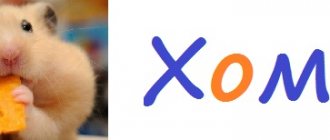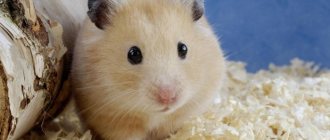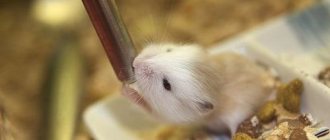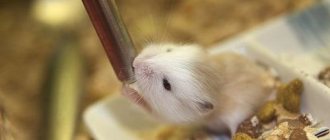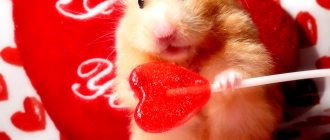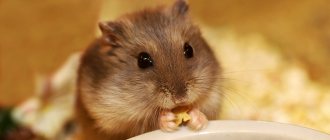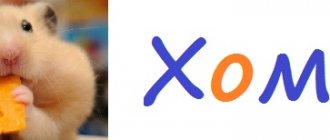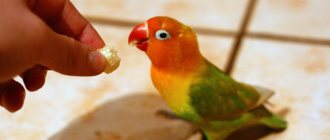A caring owner is always concerned about improving the living conditions of his pet. An important aspect of caring for a hamster is feeding. Inexperienced rodent owners are interested in how many times a day to feed a hamster so that the pet feels cheerful, stays healthy and cheerful.
Proper, nutritious nutrition is an important element that contributes to the longevity of an animal. Diet is as important as the foods that make up the animal’s diet. Read more about the list of prohibited and permitted products to avoid health problems for your pet.
Hamsters are most active at night. During the day, rodents prefer to sleep or rest. When thinking about how often to feed a hamster, you should take into account the rhythm of the animal’s life.
How many times a day should you feed your hamster?
Feeding frequency
- once - late in the evening;
- twice - in the evening and early in the morning.
If the owner determines for himself a comfortable time for feeding the animal and sticks to it, then the rodent will always wait for the food it is supposed to eat at exactly this time. And such stability in the timing of food supply has a positive effect on the animal’s digestive processes.
Also, due to their accelerated metabolism, these pets can wake up several times during the day to have a snack..
- Do not overfeed the animal - feeding twice a day is most optimal.
- Do not disturb the rodent's sleep by constantly feeding it throughout the day.
- Regularly audit inventory, removing spoiled products.
Amount of food
- what is his physical activity;
- what age is the animal, since young animals need more food ;
- what is his physiological state - a painful condition, pregnancy or lactation;
- what are the environmental conditions - room temperature.
The breeder does not have to resort to such precise mathematical calculations. It is enough to observe the animal for several days to determine how much food it needs. It is important not to overdo it with the amount of food, otherwise the hamster will quickly gain weight . This will have an impact on his health and life expectancy.
Prohibited foods can be deadly
Risk of poisoning
Poisoning is extremely dangerous for dzungarians. If poison enters the body, death can occur within a few hours. If poisoning occurs gradually, the animal may suffer for up to several days. The most common cause of poisoning is:
- poisonous seeds that got into grain feed;
- spoilage of the mixture by pests, the presence of mold, pathogenic bacteria in it;
- ingestion of poisonous plants;
- chemicals in greens;
- rot in vegetables, fruits;
- improper storage of feed.
Cause constipation
If the amount of droppings has decreased, it has become dry and hard, the hamster’s tummy is swollen, the pet is restless, and may be constipated. Its cause is most often a disruption of the intestines, insufficient consumption of fiber and moisture in the body. Trauma, stress, and pathological conditions can also provoke this state.
Constipation can be caused by:
- quince,
- pear,
- rice,
- legumes,
- canned meat.
Causes diarrhea
The cause of diarrhea in Djungarians is most often an infection, but a similar reaction to certain foods is also possible.
- citrus,
- onion,
- garlic,
- beet,
- almond.
In addition, diarrhea can be caused by a sudden change in diet, the introduction of a new product, spoiled food, or overeating. Sometimes foreign objects (small buttons, beads) enter the body while walking around the house. In this case, it is important to immediately consult a veterinarian.
Cause fermentation
For a small animal, fermentation in the gastrointestinal tract is a serious problem that leads to a significant deterioration in health. You should avoid introducing the following foods into your animal’s diet:
- potatoes,
- legumes,
- cabbage,
- sour berries
- black bread,
- sweets,
- flour products.
Legumes in general can be present in limited quantities in the diet of the dwarf, provided that the body of a particular individual is able to digest them normally.
Too fat
Hamsters are cute creatures that most owners (and more often their guests) have a regular desire to pamper. Moreover, products are chosen that seem especially tasty to the person himself. This is exactly what happens with baked goods, a variety of salty crackers, chips, puff pastries, and cheeses. Due to their high fat content, such products should not be included in the diet. Guests should be warned about this immediately to avoid troubles with the pet’s health.
Cheek pouches hurt
Some products are not dangerous, but can cause problems due to the tiny size of the dwarf and its habits. The sharp edges or hard texture of the product may cause sores on the inside of the cheek pouches. It is for these reasons that you should not give your hamster dry pasta or seeds with sharp edges (it is better to clean them).
Allergy risk
Most often, allergic reactions occur to fruits, berries, and vegetables with bright colors. You may develop a similar intolerance to certain foods due to too frequent consumption. Signs of problems may include the appearance of redness on the skin, the animal's constant desire to scratch, and watery eyes. Most often, allergies occur to strawberries, cheeses, and exotic fruits.
What does the Chilean rodent Degu eat?
Like all rodents, the degu's diet includes:
Degus are exclusively herbivores. It is best to use ready-made food for degu from trusted manufacturers (Versele-laga, Beaphar, Vitakraft), in which the optimal composition has already been selected. Chinchilla food is also suitable for feeding degus.
These rodents have the same habitat and a very similar diet. Degus should be offered hay every day as a source of fiber.
Amount of food
The amount of food depends on a number of factors. These include activity during the day, health status, and room temperature. It is also worth considering the age of the rodent, since the older the pet, the less food it needs.
The amount of food for dzhungarik should be two-thirds of the total body weight of the animal. The Syrian hamster, whose weight is 100–150 grams, eats approximately 100 grams of food per day. Djungarika will need 20 grams of food per day. However, as is the case with any other animals, everything is individual for hamsters. Therefore, you should not delve into complex mathematical calculations. It will be much more effective to simply watch the rodent during the day.
It is important not to overdo it with the amount of food, as they easily gain weight, and this has a detrimental effect on both digestion and overall health. https://www.youtube.com/embed/7o7ONxROBmc
https://youtube.com/watch?v=7o7ONxROBmc
Nutrition for elderly and sick hamsters
- Food should be predominantly chopped and grated. also give porridge with water or pureed vegetables without salt and sugar with added vitamins.
- To prevent intestinal disorders, your pet must be given grain food.
The simplest solution is to purchase a ready-made feed mixture. It is sold at any pet store and is relatively inexpensive. It has a pretty good balance of cereals and grains, which will provide the hamster with almost all the necessary elements.
Water
The life of a hamster, like almost any other living creature, is impossible without water. At the same time, many owners of such small decorative pets in vain think that they practically do not need to drink, since they do not have time to drink the entire water bottle in a day. But in reality they drink a lot. Therefore, it is worth changing the water in the drinking bowl every day.
You should also remember that the water container is a special bottle that hangs on the cage, but in no case should it be a bowl dangling under your feet. It is also important that rodents do not need to use distilled or boiled water for drinking. Tap, well, or filtered liquid, which is consumed by people themselves, is excellent for them.
Nutrition of Djungarian hamsters
- The basis of the diet of this rodent, like others, is dry food. It is recommended to purchase several different ready-made mixtures at a pet store to balance the supply of all necessary minerals and vitamins.
- Preference should be given to cereals such as buckwheat (raw and cooked), wheat (especially sprouted), oats or oat flakes, barley, pearl barley, lentils, peas, chickpeas. Minimize rice and millet in your diet.
- Raw or oven-dried sunflower seeds without salt.
- You can give milk or cheese to animals, but not more than once a week, and choose high-quality products with a minimum fat content.
- Food rich in protein is also necessary for Djungarians, and the meat should be of a lean variety (beef, chicken) . Meat and offal should be boiled without salt and spices. You can also give your pet 1/3-1/2 of a boiled egg.
- It is better to exclude fresh bread, but a small cracker once a week is allowed.
- to pamper your hamster with nuts, berries, fruits (exclude exotic ones and remove the seeds) and dried fruits , but do not overfeed them in small quantities, since a large amount of sugar in fruits can cause diabetes.
- Vegetables should also be present in the animal’s diet - cucumbers, radishes, bell peppers, cabbage, carrots, zucchini and others. It is also recommended to give various greens, such as parsley, dill, lettuce or spinach.
Djungarian hamsters will only need two main meals - in the evening and early in the morning. At the same time, food must be present in the cage around the clock - it is necessary for daytime snacks.
Are you wondering what to feed your Syrian hamster at home? In fact, the choice is quite large. The diet should be as balanced as possible, so try to include a wide variety of foods. Let's list the main ones.
Cereals
- oats,
- wheat,
- millet,
- sunflower,
- buckwheat,
- sesame,
- alfalfa.
Some experts also believe that it is beneficial for rodents to feast on melon, pumpkin and watermelon seeds. So, you can use them when preparing the feed mixture so that it is as balanced and varied as possible.
Free-living hamsters also regularly supplement their diet with grass, both fresh and dry. Hay not only improves their digestion, but also allows them to grind down their incisors. This is very important - rodents' teeth grow constantly, and if they do not wear down, then as a result your pet will lose the ability to eat normally - you will have to contact a veterinarian for help.
- clover,
- burdock,
- plantain,
- knotweed,
- whine,
- wheatgrass,
- salad,
- parsley.
By the way, speaking of hay, we can recommend keeping on hand a number of thin branches of fruit trees - cherry, pear or apple trees. Hamsters love to chew on them and are also great at grinding down overgrown teeth on them.
Fruits and vegetables
However, the choice should be taken very seriously.
Most of all, rodents love the following vegetables and fruits:
Be careful with pear - it causes stomach upset in some hamsters. So give it a little and watch your body’s reaction.
Along with the purchase of a pet, you must purchase all the equipment for keeping it: a spacious enclosure, toys, a house, a sand bath and feeders. It is recommended to buy a house and toys made of wood, as the squirrel will taste everything and constantly chew on it.
The cage should always be clean. By nature, degus are very clean creatures. They don't tolerate chaos. If the owner forgot to change the bedding or did not tidy up the cage, the pet will throw all irritants out of the cage.
Based on this, you can understand which food is optimal for degus. The exotic nature of these animals lies in the fact that their usual habitat is forests and rocks, deserts and marshy areas of South American countries. They can be found in Chile and Peru, in Brazil. They are also found in some regions of Bolivia.
If you want a charming perpetual motion machine to live at home, the movement of which is difficult to track (even if you do it very diligently), then it is quite possible that this animal can become a good friend. But for those who expect a calm dormouse creature to live with them, it is better to look for another option.
Make sure that all the necessary elements are inside the cells. These are houses and burrows; old clay pots can be used as the latter. These are very active animals. So that they have somewhere to put their energy, shelves are installed in the cages at different levels. They are attached very carefully so that the animal does not get hurt during play.
Be sure to install several bowls for food, as well as a drinking bowl. Bedding is a must. To do this, lay white paper on the bottom, and on it a layer of sawdust or pressed corn cobs. Don't forget about a running wheel, a teeth grinding stone and a sand bath for bathing.
At one time, a female hamster can give birth to 1–11 babies, depending on individual characteristics. The more hamsters there are, the smaller their weight and size will be. An animal can destroy a child who was born with defects or became ill. If the female’s first birth took place at too early an age, when the maternal instinct has not yet developed, the cubs may also face a deplorable fate.
Features of feeding a pregnant or lactating woman
While bearing and feeding offspring, the female Syrian hamster needs to eat heavily. During this crucial period, she requires a slightly larger amount of nutrients. A complex of vitamin and mineral supplements should also be introduced. The diet includes more fresh greens, sprouted grains and high-protein foods. Food should be as varied as possible and definitely healthy.
Veterinarians advise putting a mineral pebble (sold at any veterinary pharmacy), a piece of chalk, coal or calcium gluconate inside the cage as a treat. A pregnant or lactating female hamster usually has an increased appetite and she usually becomes very anxious when food is scarce. To avoid negative consequences for her and her offspring, it is recommended to increase the amount of feed given. It is better if there is always food in the bowl, but it must be fresh.
What to feed small hamsters
For the first four weeks of their lives, small hamsters feed exclusively on their mother's milk. There is no need to feed them additionally. Newborn hamsters left without a mother (or in the absence of milk from her) are fed with soy-based infant formula for the smallest (from birth 0+). You can also feed it with a cat milk replacer.
Once they reach the age of one month, they begin to be offered other food. The digestive system of babies is still very delicate, so the diet of adult hamsters is not suitable for them.
Regular grain food is poured into a bowl so that the kids can rummage through it and choose what they like. It is better not to give nuts, fruits and other treats for now, but to put them aside for later (until he grows up). Hamsters should be fed milk formula and porridge; you can mix steamed oatmeal or buckwheat flakes with baby puree (from various vegetables or meat). Gradually, one by one, other products are introduced: sprouted grains and young shoots, fresh herbs.
When can you be separated from your mother?
The living conditions should be the same as for adult hamsters: a cage with feeders, drinkers, a house, etc. After 2 months, each hamster will have to be provided with a separate cage, otherwise “wars” for territory will begin.
At the age of one and a half years, and in some cases earlier, your squirrel will become sexually mature. The cycle of females can be from 17 to 25 days; mating occurs during the estrus period. The female degu bears offspring for about three months, after which from 3 to 10 babies are born. Degu squirrels are fully formed, covered with hair and practically independent.
However, in the first weeks of life they need mother's milk, after which the babies begin to introduce themselves to adult food.
Choosing a location for the cage
Often owners do not pay attention to where to place the hamster's cage. This is a rather important point, which affects both the health and life expectancy of the animal.
Things to consider when choosing a location for a cage:
- Avoid direct sunlight on the cage;
- avoid bright light;
- limit access to the cage for other animals;
- avoid drafts;
- there should be no temperature changes in the room;
- do not place under air conditioning;
- do not place near heating devices;
- there should be no strong odors or smoke in the room;
- do not place near a TV, radio, or stereo system;
- do not place the cage in a walk-through area;
- Do not place it in a children's playroom, as hamsters are afraid of sharp and loud sounds.
For the cage you need to choose a quiet, non-passable place. The cage should not be moved frequently. The optimal temperature for keeping hamsters is 20-25 degrees.
It is necessary to install a house in the cage so that the hamster can rest during the daytime and feel safe. Also in the cage you need to put 2 feeders and a drinking bowl. Feeders with drinking bowls must be attached to the bars of the cage, otherwise an active animal will definitely turn over and trample the contents. One feeder is needed for the grain mixture, which is the main feed, the other is needed for succulent feed.
The basis of the diet of the dzhungarik
The diet of Djungarian hamsters is similar to that of other rodent species. The basis of the dzhungarik's diet is often a special grain feed, which is a mixture of various grains, legumes, vitamins, nuts and various additives.
Special pet stores have a huge selection of such foods, where you can choose a grain mixture for your pet. All store-bought foods differ not only in composition, but also in quality. Sometimes hamsters refuse to eat a certain brand of food, in this case you should not immediately turn away from the purchased mixture. Be sure to offer your pet food from a different manufacturer with slightly different ingredients after a couple of days.
Experienced hamster breeders recommend feeding their pets balanced mass-produced food, since its composition also includes various types of herbs, carefully pressed into granules.
If there is no pet store nearby, you can prepare the mixture for feeding the rodent yourself. To prepare grain food for your pet, you need to mix buckwheat, wheat, barley, rolled oats, and legumes (peas, beans, beans, lentils) in equal proportions.
Another option
Experts and those who breed hamsters advise not to get carried away with vitamins. Even if you buy domestic food for your animal, the best option for it is not a vitamin complex, but a pack of imported food. It should be mixed with domestic one, and as a result you will have a mixture with all the necessary vitamins. It will cost you less.
So decide for yourself which option to use. Observe your pet and draw conclusions about what will be best for him - be guided by this.
Please rate the article
4.1730769230769 Rating 4.17 (26 votes)
